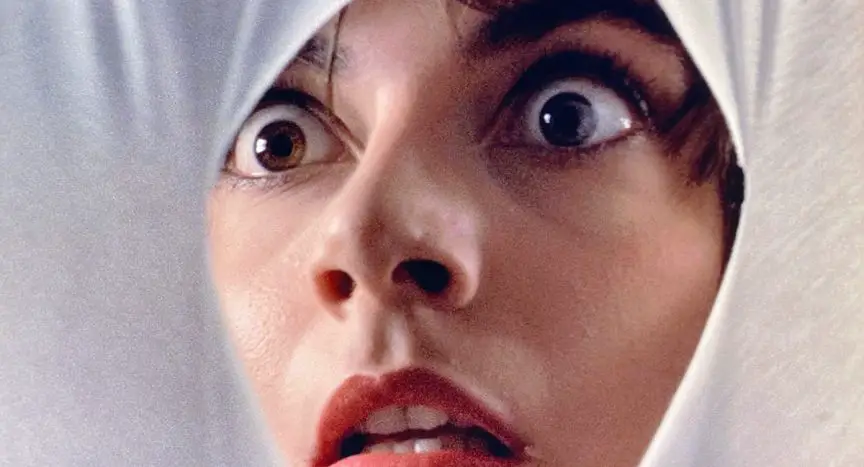Folks of all sorts love to refer to Howard Hawks’s maxim: “A good movie is three great scenes and no bad ones.” Even if you buy it, you must concede that there’s always an exception that makes the rule. Iconic case in point: Dario Argento usually gives you three (or four or ten or however many great scenes), but he can sometimes give you just as many bad ones too.
You can go ahead and attempt to argue against Argento’s grandmaster status, but cinema is art. Period. And Argento’s idiosyncrasy of artistic vision is of an exemplary uniqueness. Period. Even working in an industry intent on sacrificing much for efficiency’s sake–and within genres that tend to cling to workhorse conventions like shipwreck driftwood –Argento’s films, for better or worse, are more than just peculiar. They are distinctively peculiar. In the case of an Argento film, those three or four (or ten) great scenes are never simply plain old great scenes–they’re very often singular scenes without precedent. They balk at the concept of explicability. They’re very often made up of unforgettable incomprehensibility. But as plots and details fade over time, his most striking set-pieces are classically tenacious.
On the other side of the coin, Argento’s bad scenes are sometimes just as striking. Sometimes you and I will not agree at all on which scenes are good and which scenes are bad. Sometimes he even makes a scene that is both. Sometimes an Argento film will rapidly ricochet from a sort of ineptitude right to the strokes of orgasmic movie-making genius, all without warning. The sacrifice of consistency in favor of legitimate authorial eccentricity is a very easy sacrifice to embrace.
When it comes to Argento, Tenebrae belongs to the upper echelon–the same category as Suspiria and Profondo Rosso (arguably Opera and (even more arguably) The Stendhal Syndrome too). Temporarily abandoning his notorious employment of moody colored light, Tenebrae is a film instead scalded by the harsh white illumination of the mundane. The starkness of the visual approach makes the suddenness of flamboyant gore feel all the more extreme. The violence in the film seems to transcend our comprehension of the world around us. Another case in point: the dismemberment that initiates the climax of the film remains one of the most guttural, strange, and jaw-dropping sequences ever filmed. Period.
Did You Know? Wicked Horror TV Has Classic and Independent Horror Films Available to Stream for Free!
If Suspiria is a film of dreams, then Tenebrae is a film where the distinction between dream and reality has become irrevocably blurred. Despite the semblance of the familiar–the impression of the normal in every brightly lit and realistic scenario–that uncanny feeling that we must be asleep still encroaches.
Set apart from this, however, Tenebrae’s most uncanny sequence (and one of its many great ones) is a cinematic rival to Jean Rollin’s renderings of dreamy coastal gothicism. Haunted by a soundtrack selection fittingly entitled ‘Slow Circus’, but otherwise eerily quiet, this conjuring of a traumatic beach-set nightmare is delectably skin-chilling. It pumps cold blood with an impressively Aickman-esque sexual unease. It could all be discounted as strictly pseudo-Freudian stuff, were it not so aggressively stylized as to render explicability incompatible with the contents of the scene. Dialogue in the film’s denouement seems to indirectly reference this event–another linked remembrance is more concrete in narrative function–but without doing anything to expound its specifics.
The final moments of the film–where cries of fear are only expunged by the callous roll of routine end credits–fail to promise any chance of waking from the nightmare. The finale, queasy to the nth degree, resolves none of the film’s internal contradictions and tenders no solutions to the social quagmires depicted.
See Also: A Beginner’s Guide to Dario Argento
Argento was perhaps working in a reactionary manner. Criticisms of his work’s ongoing misogyny manifest explicitly in Tenebrae’s self-referential elements. The film’s protagonist–a writer of lurid crime paperbacks–is chastised by a female journalist in one of the funnier scenes. He brushes off the accusatory probe, but meanwhile a killer inspired by his work has been murdering one woman after the next. Argento does not dismissively label the accusation as moralistic posturing. However, Argento continually has no qualms about visualizing the graphic murder of beautiful women. Neither does he shy away from routinely exhibiting their nude bodies immediately prior to.
But, in what is perhaps the film’s greatest of great scenes, Argento insists that his artistic interests do indeed venture beyond the vicious, unsavory, and voyeuristic. The camera takes on the point of view of the standard giallo’s murderous black-gloved monster, but just then rises up, transcending the logistics of a human perspective. The camera, in a virtuosic unbroken take, scales the side of a house, roams about in space and time, and in so doing unhinges the movie from all pragmatic purposes, catharses, and logic. At the end of the take, our view is returned to whence it came. But this sequence is so magisterial and so strange that it completely eclipses the violence that follows.
Supposedly, producers begged for this sequence to be cut. There is something deeply horrific about being made to realize that you are more accustomed to witnessing the butchering of women than you are to such aesthetic digressions.
Also See: Script to Pieces: Argento and Nicolodi’s Mother of Tears
If a copy of Tenebrae is absent from your library of physical media then your library of physical media lacks at least one copy of Tenebrae. Synapse Films has put together a 4K Ultra HD and Blu-Ray combo package that is a noble choice to solve such an absence. The bevy of special features have been expanded from their 2016 Blu-Ray release of the film, so it is more scholarly and definition-minded viewers who will want to spring for such an upgrade. Synapse’s three-disc limited edition of Tenebrae (released last year) also included a UHD presentation of the film’s butchered original US cut Unsane (which, ironically perhaps, skimps on the butcherings). Personally, I own a very-much-so not-UHD presentation of the Unsane cut of the film on the beloved Mill Creek Entertainment’s 2009 ‘Drive In Movie Classics’ 50 movie DVD pack (which is more than enough of the Unsane cut for me).
Wicked Horror Rating: 10/10
Synapse Films unleashes Dario Argento’s Tenebrae on 4K UHD from a new 4K restoration from the original camera negative, presented in Dolby Vision (HDR10 compatible) in its original 1.85:1 aspect ratio with restored original DTS-HD MA lossless mono Italian and English soundtracks and English subtitles for the Italian soundtrack on September 26th.






